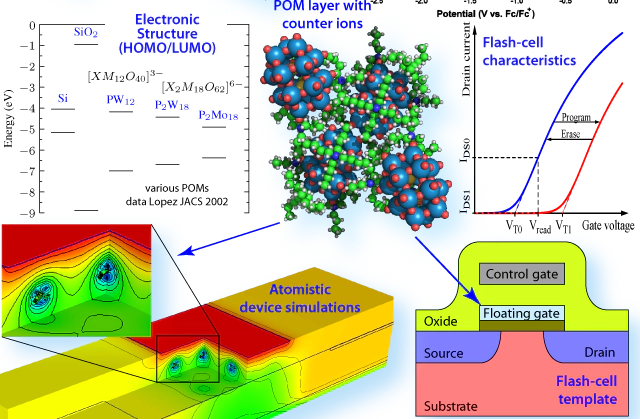Molecular electronics

Our aim is to establish a link between the chemistry, device fabrication and device design and numerical modelling.
Molecular electronics gives us the exciting opportunity to research novel devices and materials. In particular, we investigate a non-volatile flash-memory cell’s viability, scalability and variability, in which the charge-storing component is a layer of polyoxometalate molecular clusters (POMs).
The idea is to utilise the highly attractive redox properties of the POMs – they are multiply and reversibly reducible, which could facilitate multi-bit storage per transistor cell. The small size (~1nm) of the POMs and the variety of their structure, which can be controlled via chemical synthesis and determines their electronic properties, makes them attractive for memory applications.
Fundamentally, we aim to establish a link between the two traditionally distinct fields of molecular design and modelling and device design and modelling and to exemplify the synergy derived from the diverse expertise held at each area.
Selected publications:
Dixit, A., Ghosh, R., Jacobs, J., Kumar, N., Vila-Nadal, L., Asenov, A, Paul, D. J. and Georgiev, V. (2025) Nanowire behavior under the influence of polyoxometalates: a comparative study of depletion and enhancement modes. Solid-State Electronics, 228, 109145. doi: 10.1016/j.sse.2025.109145
Lapham, P., Vilà-Nadal, L. , Cronin, L. and Georgiev, V. P. (2021) Influence of the contact geometry and counterions on the current flow and charge transfer in polyoxometalate molecular junctions: a density functional theory study Journal of Physical Chemistry C, 125(6), pp. 3599-3610. doi: 10.1021/acs.jpcc.0c11038 (PMID:33633816) (PMCID:PMC7899180)
Busche, C. et al. (2014) Design and fabrication of memory devices based on nanoscale polyoxometalate clusters Nature, 515(7528), pp. 545-549. doi: 10.1038/nature13951 (PMID:25409147)
Georgiev, V. P. , Markov, S., Vila-Nadal, L. , Busche, C. , Cronin, L. and Asenov, A. (2014) Optimization and evaluation of variability in the programming window of a flash cell with molecular metal-oxide storage IEEE Transactions on Electron Devices, 61(6), pp. 2019-2026. doi: 10.1109/TED.2014.2315520